| The Cayo and Stann Creek Districts are under strict surveillance by the Belize Agricultural Health Authority after cattle in Cayo and pigs in Stann Creek started showing symptoms of a disease called vesicular stomatitis, known locally as sore mouth.
There have been three reports from villages in the Cayo District and one report from the Stann Creek District.
We went to one of those villages in Cayo today, the community known as Lower Barton Creek, where life moves at a different pace, but livestock disease travels at its own pace.
Jules Vasquez Reporting
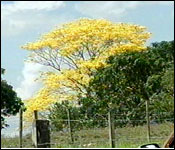
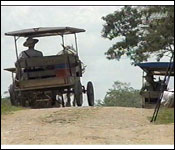
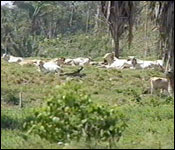 The Yellow Cortez Tree in dazzling full flower above Barton Creek sets the tone nicely for this rustic community where there are no engines, no electricity, and no radio - everything is powered by horse in this farming community which appears frozen in time.
The Yellow Cortez Tree in dazzling full flower above Barton Creek sets the tone nicely for this rustic community where there are no engines, no electricity, and no radio - everything is powered by horse in this farming community which appears frozen in time.
It is a picturesque location, set against the foothills of the mountain pine ridge - but the natural grandeur and quaint old world charm of the setting is disrupted by this sign - BAHA Quarantine. It abuts a fence within which are 110 head of cattle, 50 to 60 of them infected with what appears to be vesicular stomatitis or sore mouth disease:
Dr. Miguel Depaz, Director Animal Health BAHA
"At this time we highly suspect vesicular stomatitis. We have the farms under pre-quarantine, in other words we are not allowing the movement of pigs, horses, cattle out of the affected farms."
That's why we too had to keep a distance of over a hundred feet but these photos - provided to us by the BAHA inspectors who checked the same cows - shows what it looks like. The tell tale signs are the abrasions on the gums, but there are other symptoms:
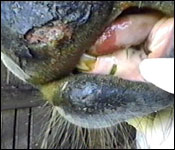
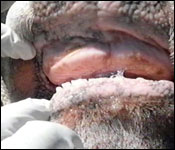
Dr. Miguel Depaz, Director Animal Health BAHA
"For vesicular stomatitis - the clinical signs would be vesicles and where do you see the vesicles? It's on the lips, in the mouth - meaning the pallet, the gum, the tongue. You could get vesicles on the tip of the udder and just above the hoof - the coronary band, we refer to that area as the coronary band, you could get vesicles there and so the animal would be salivating, the animal would have lameness. Those are the signs that farmers should look for. If the farmer sees those signs - they should call BAHA or the ministry of agriculture. It's transmitted by mosquitoes. Mosquitoes are the vector of the disease. In other words you could control the disease by eliminating breeding grounds of the mosquitoes. At this time we have identified the affected districts to be Cayo and Stan Creek, hopefully we do not see it in the north. Nevertheless it's a zoonotic disease meaning that it can be transmitted from human to animal - the live animal can transmit the disease to human if the human is in close contact with that animal, a human would have flu-like symptoms in other words headache and a fever, muscle aches. This disease - vesicular stomatitis if we confirm it should disappear in about two weeks' time, that's the period that the disease would last - two weeks."
"I am very sure that we will contain and given the dynamics of the disease, in two weeks' time the disease on its own should disappear - that's the time period it lasts so I am definitely sure we will contain it."
They will contain it, but the village Chairman and an elder - who also don't do interviews - explained that it won't be in time to save this community from major losses particularly with their 600 pigs, 100 of which are coming up for slaughter in the next few days - but can't be slaughtered because of the quarantine leading to losses estimated to be in excess of ten thousand dollars for this community of 50 families.
And while they worry about their livestock, BAHA is worrying about the similarities between this endemic disease and a another far more exotic and troublesome disease
Jules Vasquez
"Is there a lurking fear in your mind that it may be something exotic like foot and mouth?"
Dr. Miguel Depaz, Director Animal Health BAHA
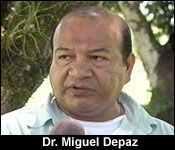 "Well with vesicular diseases you have to think foot and mouth disease, I must say that with lots of precaution because it could have serious implications. But you have to think foot and mouth disease although that has never been reported in Central America. Foot and mouth disease have never been reported."
"Well with vesicular diseases you have to think foot and mouth disease, I must say that with lots of precaution because it could have serious implications. But you have to think foot and mouth disease although that has never been reported in Central America. Foot and mouth disease have never been reported."
And BAHA is anxiously awaiting the results of samples sent to Panama to confirm that it is not foot and mouth disease, which would be the only good news coming out of this situation.
So far, horses in lower Barton Creek have not been quarantined because this would cripple the community. In the words of one village elder to us, "it would be like taking away your cars and phones."
BAHA warns that human infection may develop from exposure to infected animals when proper precautions are not taken. The white tailed deer and small mammals may be infected in the wild.
Belize frequently reports vesicular stomatitis at the start of the dry period, usually in the Cayo District.
The last major outbreak happened in 1997 and that year, they had to ban animal displays at the Agriculture Trade Show.
In 2004, it was reported for the first time in the Orange Walk District.
Most times, farmers don't even bother reporting the disease as it is self-limiting with infected animals showing rapid improvement within 3 days and full recovery by 2 weeks.
After a bout of it, livestock can be cleared or slaughter without any adverse health risks.
And hoping that this is vesicular stomatitis - we'll keep in touch with BAHA to find out the results of the samples sent to Panama for testing.
| 
